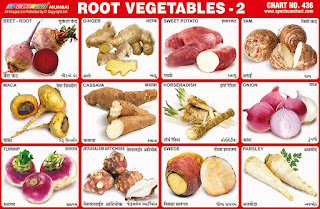 |
| Root Vegetables 2 Chart |
Spectrum Chart - 436 : Root Vegetables 2
1. Beet Root - Fresh beetroot is a rich
red coloured, round shaped, root vegetable with long stems and green
leaves. Beet is known for cleansing the blood which in turn helps
major organs to function well, it also helps in detoxifying the body
and assisting the digestive system.
2. Ginger - Ginger is commonly used as a
cooking spice throughout the world. It has been used to help
digestion, reduce nausea and help fight the flu and common cold.
3. Sweet Potato - Sweet Potato is a tuber
or an exotic root vegetable. The nutritional value of sweet potato is
very high as there are so many vitamins and nutrients also contains
several B vitamins including vitamin B1, vitamin B3, vitamin B5 and
vitamin B6.
4. Yam – Yam is the common name for some
plant species in the genus Dioscorea that form edible tubers. Yam is
a vegetable that can be cooked in may ways. It can be barbecued,
roasted, fried, grilled, boiled, baked, smoked and when grated it is
used in desserts. The inside ranges in colour from white or yellow to
purple or pink in mature yams.
5. Maca - Maca is mainly grown for the
nutritional and health value of its root. Maca is consumed as food
for humans and livestock, suggesting any risk from consumption is
rather minimal. It is considered as safe to eat as any other
vegetable food.
6. Cassava - Cassava is a woody shrub
native to South America. It is an annual crop in tropical and
subtropical regions for its edible starchy tuberous root, a major
source of carbohydrates. Cassava is the third largest source of food
carbohydrates in the tropics, after rice and maize. Cassava is a
major staple food in the developing world, providing a basic diet for
over half a billion people.
7. Horseradish - Horseradish is a
perennial plant of the Brassicaceae family. It is a root vegetable
used as a spice. Horseradish sauce made from grated horseradish root
and vinegar is a popular condiment. Horseradish is also used as a
main ingredient for soups.
8. Onion - Onions are low in calories, it
is a good, healthy vegetable particularly when eaten raw. There are
approximately 325 different varieties of onions, most popular types
are Red Onion, Yellow Onion and Spanish Onion.
9. Turnip - Turnip is a root vegetable
belonging to the cabbage family. Turnips are smaller in size, they
are round in shape and white in colour, tinged with green, pink or
white.
10. Jerusalem Artichoke - Jerusalem
artichoke is a species of sunflower native to eastern North America.
It is cultivated widely across the temperate zone for its tuber,
which is used as a root vegetable. Tubers are sometimes used as a
substitute for potatoes, they have a similar consistency and in their
raw form have a similar texture, but a sweeter, nuttier flavor, raw
and sliced thinly, they are fit for a salad.
11. Swede - Swede is a root vegetable that
originated as a cross between the cabbage and the turnip. The roots
are prepared for human food in a variety of ways and the leaves can
be eaten as a leaf vegetable. The roots and tops are also used as
winter feed for livestock.
12. Parsley - Parsley is grown as a root
vegetable. This type of parsley produces much thicker roots than
types cultivated for their leaves. Root parsley is common in central
and eastern European cuisine, where it is used in soups and stews or
simply eaten raw as a snack.

No comments:
Post a Comment